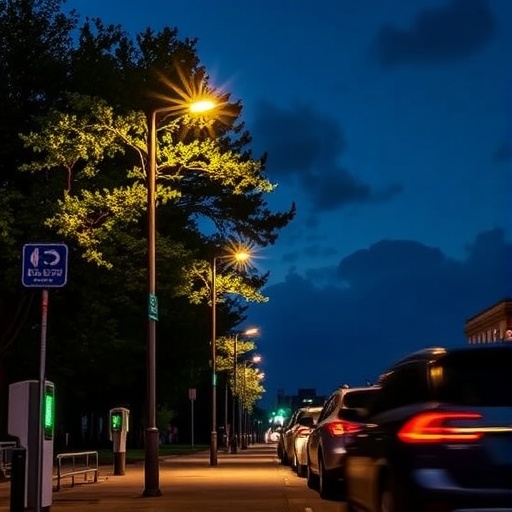Electric vehicles (EVs) are poised to transform the landscape of urban transportation, offering an environmentally friendly alternative to traditional gasoline-powered cars. While their benefits include reduced emissions and lower operational costs, the widespread adoption of EVs hinges on the development of accessible charging infrastructure, particularly in urban areas and multi-unit dwellings. A critical challenge arises for residents in these environments, where access to dedicated EV chargers is limited, often resulting in reduced adoption rates of electric vehicles.
To tackle this pressing issue, researchers at Penn State University have pioneered an innovative and scalable framework that repurposes existing streetlight infrastructure as a convenient and cost-effective solution for EV charging. This groundbreaking approach leverages the substantial network of streetlights already present in cities—typically owned and maintained by local municipalities. Since these poles are already powered, they offer a unique opportunity for enhancing the availability of charging stations without the need for extensive new infrastructure investments.
The Penn State team conducted extensive research and implemented their framework in Kansas City, Missouri, where they installed 23 streetlight EV charging units. Their key motivations stemmed from a desire to increase accessibility to charging networks, especially for residents of apartments and condos who often lack dedicated home charging options. Participating in this project allowed researchers to test the framework in real-world conditions, providing valuable data on both feasibility and efficacy.
The research revealed that charging stations integrated with streetlights considerably outperformed traditional EV charging stations across multiple metrics. Firstly, they were found to be much lower in installation costs; the existing infrastructure of streetlights significantly reduced the need for extensive groundwork commonly required for standalone charging stations. Secondly, these streetlight charging units offered faster charging speeds, attributed to their connection to dedicated municipal electrical lines that faced less demand from competing vehicles. This translates into added convenience for EV users, who benefit from quicker turnaround times while charging.
Another compelling advantage of the study’s findings relates to environmental impacts. By utilizing the existing streetlight poles, emissions associated with the installation of new charging infrastructures are avoided. Moreover, the resulting increase in EV usage supports broader goals of reducing greenhouse gas emissions, especially when these charging stations are strategically placed in high-demand areas where vehicles are already parked. This innovative framework not only aims to enhance local mobility but also plays a crucial role in supporting sustainable urban electrification efforts.
Researchers employed an observation-centered approach to evaluate the demand for EV streetlight charging units, analyzing various factors such as local land use patterns, station density, proximity to significant points of interest, and traffic volume. By incorporating artificial intelligence into their analysis, they developed predictive models to forecast demand based on these identified factors. The results indicated not only a palpable need for such infrastructure but also provided critical insights into how these streetlight chargers could be effectively distributed across urban neighborhoods.
Equity played a fundamental role in the researchers’ approach. Engaging proactively with communities ensured that the distribution of charging benefits was fair and accessible, especially in areas that have historically been underserved in terms of EV infrastructure. This community-centric ethos aligns with wider goals of fostering inclusivity in urban planning and development.
Data collected over the course of one year post-installation revealed significant advantages. The streetlight EV charging stations proved to be economically viable, offering a cost-efficient alternative that minimized the need for large-scale capital investments. The research team’s commitment to transparency and data sharing enhances the framework’s viability as a model that can be easily replicated in various communities across the nation.
As researchers continue to delve deeper into this promising approach, they emphasize the necessity of further refining their models by integrating more granular socio-economic data and relevant weather information. Incorporating these variables will empower them to identify communities that are currently underserved regarding EV access and adoption potential, thus facilitating even more tailored infrastructure development. Moreover, understanding how weather fluctuations affect battery performance and operational dynamics will further bolster the reliability and efficiency of public charging stations.
This innovative streetlight charging framework, funded through the support of the U.S. Department of Energy, stands as a testament to the power of public-private partnerships in addressing real-world challenges. Collaborating with local utilities, non-profit organizations, and other stakeholders showcases how academia can effectively translate research into practical solutions, promoting sustainable urban development.
In conclusion, researchers at Penn State University have laid the groundwork for a transformative framework that has the potential to expand EV infrastructure dramatically. By integrating streetlight poles into the EV charging ecosystem, they not only forge pathways to enhanced mobility but also promote equity and sustainability. As the urban landscape continues to shift towards electrification, innovative interventions like streetlight charging could become cornerstones in crafting a cleaner and more accessible future for urban transportation.
The collaborative efforts undertaken in this research bring hope for a future where EV charging is ubiquitous and equitable, paving the way for a tomorrow where electric vehicles are not just a privilege but a practical choice for every urban dweller. As urban planners and policymakers worldwide take note, the implications of this framework may inspire broader changes needed to reinvigorate our transportation networks while prioritizing both community engagement and environmental consciousness.
Subject of Research: Repurposing streetlight infrastructure for EV charging.
Article Title: Equitable Urban Electric Vehicle Charging: Feasibility and Benefits of Streetlight Charging in Kansas City Right-of-Way
News Publication Date: 23-Sep-2025
Web References: Journal of Urban Planning and Development
References: Penn State University, U.S. Department of Energy
Image Credits: Provided by XB Hu/Penn State
Keywords
Electric vehicles, charging infrastructure, sustainability, urban planning, community engagement.




